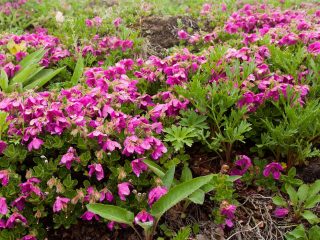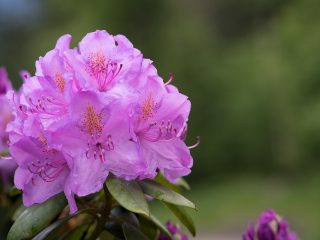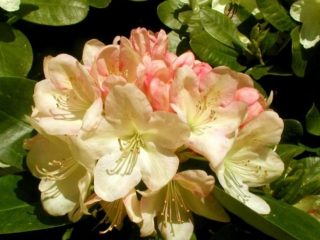Content
Rhododendron Nova Zembla is very popular among gardeners due to its decorative properties and ease of care. It can be grown almost anywhere.
Description of Rhododendron Nova Zembla
Hybrid rhododendron Nova Zembla is a perennial evergreen shrub of the Ericaceae family. The plant has excellent decorative qualities and good frost resistance. The height of the Nova Zembla rhododendron bush reaches 2 m, while it grows in width by the same distance. The crown shape is dome-shaped, the branches are spreading. Sometimes it blooms twice per season - in summer and autumn.
The leaves are large, slightly elongated, dark green on the outside and gray on the back. The main detail in the description of the Nova Zembla rhododendron is its flowers. They are bright ruby in color with brown dots in the center and yellow anthers, resembling a bell in appearance.Their diameter ranges from 6 to 10 cm, collected in inflorescences of up to 12 pieces. The bush has a powerful trunk covered with gray bark and strongly branched shoots. The root system is superficial.
Rhododendron Nova Zembla is shown in the photo:
In landscape design, shrubs are not planted in a small space. The plant is placed near ponds or near the house. The shrub is also used in group plantings. The description of the Nova Zembla rhododendron variety, its photos and reviews from gardeners indicate that the plant is quite common both in landscape design and as single plantings in summer cottages.
Winter hardiness of rhododendron Nova Zembla
The Nova Zembla variety tolerates low and high temperatures well. The shrub survives at temperatures from - 32 °C to + 35 °C. Comfortable conditions for it are from - 10 °C to + 25 °C.
Therefore, in cold regions such as Siberia or the Urals, the plant must be covered in winter. The same applies to young, not yet mature bushes. Rhododendron Nova Zembla may be black after winter; as a rule, this indicates fungal growth on the plant under cover.
Conditions for growing hybrid rhododendron Nova Zembla
Nova Zembla rhododendron combines well with pine, oak, larch, and fruit trees. The shrub should not be planted next to plants with shallow root systems, otherwise they will compete for nutrients.
When growing Nova Zembla rhododendron, it is recommended to adhere to the following conditions:
- It is better to plant either in the spring in April-May, or in the fall in September-November;
- if you need to plant rhododendron in other periods, then you should wait until the flowering time and two weeks after it;
- Shrubs are located on the northern side of the buildings, slight shading is possible.
Planting and caring for rhododendron Nova Zembla
Planting and caring for the hybrid Nova Zembla rhododendron is not difficult. The plant has adapted well to various climatic conditions. The shrub will feel great in both northern and southern regions.
Selection and preparation of a landing site
It is better to choose a site for rhododendron in partial shade. You should not place the bush in windy, low places. The soil is acidic, loose, and contains enough nutrients. The groundwater must be low, otherwise you will have to raise the bed with the Nova Zembla rhododendron. The plant does not like high humidity and wetlands.
If the soil on the site is not fertile enough, it should be improved. To do this, add a mixture of peat, sand, turf soil, compost, coal, humus, and perlite. All components are added in equal parts, and charcoal is added in small quantities.
Seedling preparation
It is better to purchase rhododendron hybrid Nova Zembla in specialized stores, thus reducing the risk of taking a diseased plant. When the seedling is removed from the container, the earthen ball should be thoroughly soaked with water. It is immersed in liquid and wait until the release of air bubbles stops.
When planting, the bush is immersed in the soil to the same depth as in the container.
If the roots are very long, they are lightly trimmed and then straightened out in the planting hole. In this case, you must try not to seriously injure the plant.
Landing rules
The best time to plant Nova Zembla rhododendron is spring. The following recommendations should be followed:
- the hole for the seedling should be about 50 cm deep and 80 cm wide or more;
- At the bottom, drainage is made from a layer of sand and crushed brick approximately 20 cm thick;
- the bush is deepened to the level where the root collar is located;
- the root is straightened in the center of the hole and covered with soil;
- for rhododendron, make a hole near the trunk, water the plant, and spray its foliage with water;
- The final stage is mulching with peat, pine needles or bark.
Watering and fertilizing
Watering rhododendron Nova Zembla requires the following conditions:
- the shrub needs a lot of water; in hot weather, pour up to 12 liters per plant up to 3 times a week;
- if there is a lack of moisture, expressed in lethargy or browning of leaves, then increase watering;
- soft water with a low salt content is suitable for rhododendrons;
- the foliage of the bush needs to be sprayed, especially during the period of active development;
- after watering, the soil must be loosened; this must be done carefully so as not to damage the root system at the surface;
- Weeds removed by loosening are recommended to be used as mulch.
When fertilizing rhododendron, the content of nutrients in the soil is taken into account. Fertilizers are applied to fertile soil 2 times a year. In this case, you should follow a number of rules:
- in the spring, complex products are applied under the bush, as well as mineral elements: ammonium sulfate, potassium sulfate, superphosphate;
- The plant needs a second feeding after flowering: phosphate and potassium mixture;
- young seedlings are fed with fertilizers in liquid form.
Trimming
Rhododendron Nova Zembla does not need formative pruning; the bush itself grows quite neatly. All procedures are carried out in the spring before sap flow begins. Mainly used are sanitary and anti-aging pruning.
The bush is rid of dried, weak and diseased shoots. If thick branches are injured, the cut sites are treated with garden varnish.
The old bush is rejuvenated in two stages. In one year, branches up to a size of 30 cm are removed on one part of the plant, in another - on the second part. When frosting occurs, do the same with rhododendron.
The peculiarity of the flowering of the shrub is its cyclical nature - lush flowering in the next season is replaced by a more moderate one. To preserve decorativeness, the inflorescences are removed without allowing fruit to set. In this way, abundant flowering is achieved every summer.
Preparing for winter
Before the winter period, the Nova Zembla rhododendron must be well watered so that the plant has time to accumulate a sufficient supply of moisture. The height of the mulch layer is increased to 15 cm. It is recommended to cover the bush with spunbond to protect it from fading under the bright winter sun.
Reproduction
Nova Zembla rhododendron is propagated by cuttings or layering. Both methods are quite effective.
Cuttings are harvested in the second half of June. Their length should be about 8 cm. Planting material is treated with a growth stimulator and placed in a mixture of peat and sand for germination. It is necessary to ensure that the lower cut of the shoots is oblique at an angle of about 45 °.Ideal rooting conditions can be created in a greenhouse - it is easy to maintain the required humidity and temperature there.
When 3-4 leaves form on the cuttings, they are divided into containers. The seedling will move to its permanent location in a year.
It is a little easier to propagate Nova Zembla rhododendron by layering - in the spring you need to dig in one of the lower branches, fixing it with a bracket on the ground. The shoot must be carefully cared for, in no case allowing the soil to dry out. For better rooting, you can use special means. Next autumn the bush can be planted in a permanent place.
Diseases and pests
Rhododendron Nova Zembla is subject to attacks by the following pests:
- Acacia false scale - a small insect with an oval-shaped body and brown color. The larvae pierce the bark and attach themselves to the plant. The bush becomes weaker and eventually dies. An effective measure against acacia false scale is to treat it once every 10 days with organophosphorus fertilizers.
- Sulcata weevil - a small beetle, black in color. It can destroy the plant if protection measures are not taken in a timely manner. In summer, the pest is especially active, so during this period the soil and bush are treated with Furadon and Bazudin.
- Aphid - a small insect that, uniting in colonies, drinks the sap of a plant and is capable of destroying it in a short time. Medicines designed to kill weevils will save you from the pest.
- Snails and slugs They mainly damage plant leaves by actively eating them. The main control measure is to manually collect the pest and place substances that repel slugs near the rhododendron bush.
Rhododendron Nova Zembla is susceptible to the following diseases:
- Tracheomycosis or vascular wilt - caused by a fungus. Leaves and stems quickly wither, becoming covered with a gray coating. If signs of the disease are detected, the dead parts are removed and the bush is treated with Bordeaux mixture.
- Root rot - affects roots and stems. The plant rots and then dies. The disease is manifested by yellowing and drying of leaves, as well as falling buds. Infected parts are burned, and if the disease spreads strongly, the entire bush is destroyed.
- Septoria spot - The causative agent is a fungus. It appears as red spots, the middle of which turns white over time. Then black dots appear - fruiting bodies. The leaves turn yellow, dry out and fall off. The disease is common among plants in a greenhouse. All physiological processes are disrupted, and flower buds do not form. Control measures - in the spring the bush is sprayed with preparations containing copper, and in the summer with fungicides.
Conclusion
Rhododendron Nova Zembla has proven itself well and is not losing ground, remaining a favorite of summer residents. Caring for it is accessible even to beginners in gardening. The only thing that needs to be taken into account is that you need to allocate enough space for the spreading bush.
Reviews of rhododendron Nova Zembla












